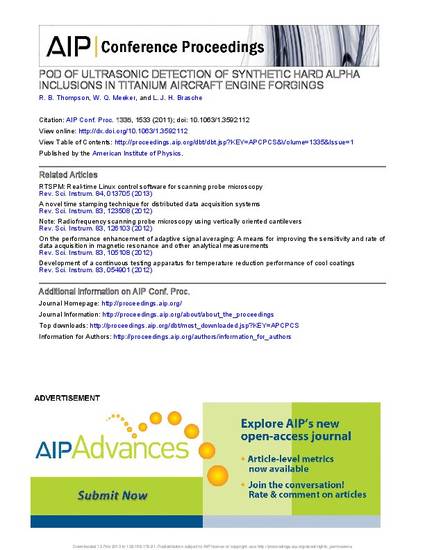
Presentation
Pod of ultrasonic detection of synthetic hard alpha inclusions in titanium aircraft engine forgings
Center for Nondestructive Evaluation Conference Papers, Posters and Presentations
Document Type
Conference Proceeding
Disciplines
Conference
Review of Progress in Quantitative Nondestructive Evaluation
Publication Date
7-1-2010
Geolocation
(32.7153292, -117.1572551)
Abstract
The probability of detection (POD) of inspection techniques is a key input to estimating the lives of structural components such as aircraft engines. This paper describes work conducted as a part of the development of POD curves for the ultrasonic detection of synthetic hard alpha (SHA) inclusions in titanium aircraft engine forgings. The sample upon which the POD curves are to be based contains four types of right circular SHAs that have been embedded in a representative titanium forging, as well as a number of flat bottomed holes (FBHs). The SHAs were of two sizes, #3 and #5, with each size including seeds with nominal nitrogen concentrations of both 3 and 17 wt. %. The FBHs included sizes of #1, #3, and #5. This discreteness of the data poses a number of challenges to standard processes for determining POD. For example, at each concentration of nitrogen, there are only two sizes, with 10 inspection opportunities each. Fully empirical, standard methodologies such as versus a provide less than an ideal framework for such an analysis. For example, there is no way to describe the beam limiting effect whereby the signal no longer increases the flaw grows larger than the beam, one can only determine POD at the two concentration levels present in the block, and confidence bounds tend to be broad because of the limited data available for each case. In this paper, we will describe strategies involving the use of physics‐based models to overcome these difficulties by allowing the data from all reflectors to be analyzed by a single statistical model. Included will be a discussion of the development of the physics‐based model, its comparison to the experimental data (obtained at multiple sites with multiple operators) and its implications regarding the statistical analysis, whose details will be given in a separate article by Li et al. in this volume.
Copyright Owner
American Institute of Physics
Copyright Date
2011
Language
en
Citation Information
R. Bruce Thompson, William Q. Meeker and Lisa H. Brasche. "Pod of ultrasonic detection of synthetic hard alpha inclusions in titanium aircraft engine forgings" San Diego, CA(2010) Available at: http://works.bepress.com/wqmeeker/2/

Copyright 2011 American Institute of Physics. This article may be downloaded for personal use only. Any other use requires prior permission of the author and the American Institute of Physics.
This article appeared in AIP Conference Proceedings 1335 (2011): 1533–1540 and may be found at http://dx.doi.org/10.1063/1.3592112.